Data Analysis and Forecasting for Numeracy Module, LSC, Suffolk
VerifiedAdded on 2022/12/14
|9
|1370
|86
Homework Assignment
AI Summary
This assignment solution provides a comprehensive analysis of data analysis techniques and forecasting methods. The report begins with an introduction to data analysis and its significance in deriving meaningful insights from data. The main body of the assignment includes the arrangement of expense data in a tabular format and its presentation through line and column charts. It then delves into the calculation and discussion of statistical measures such as mean, median, mode, range, and standard deviation, providing step-by-step calculations and interpretations. Furthermore, the solution incorporates a linear forecasting model to predict future spending on transportation, calculating 'm' and 'c' values and forecasting expenses for specific months. The report concludes with a summary of the findings and references relevant sources, demonstrating the practical application of data analysis in making informed decisions.

Numeracy and Data AnalysisNumeracy and Data Analysis
Paraphrase This Document
Need a fresh take? Get an instant paraphrase of this document with our AI Paraphraser
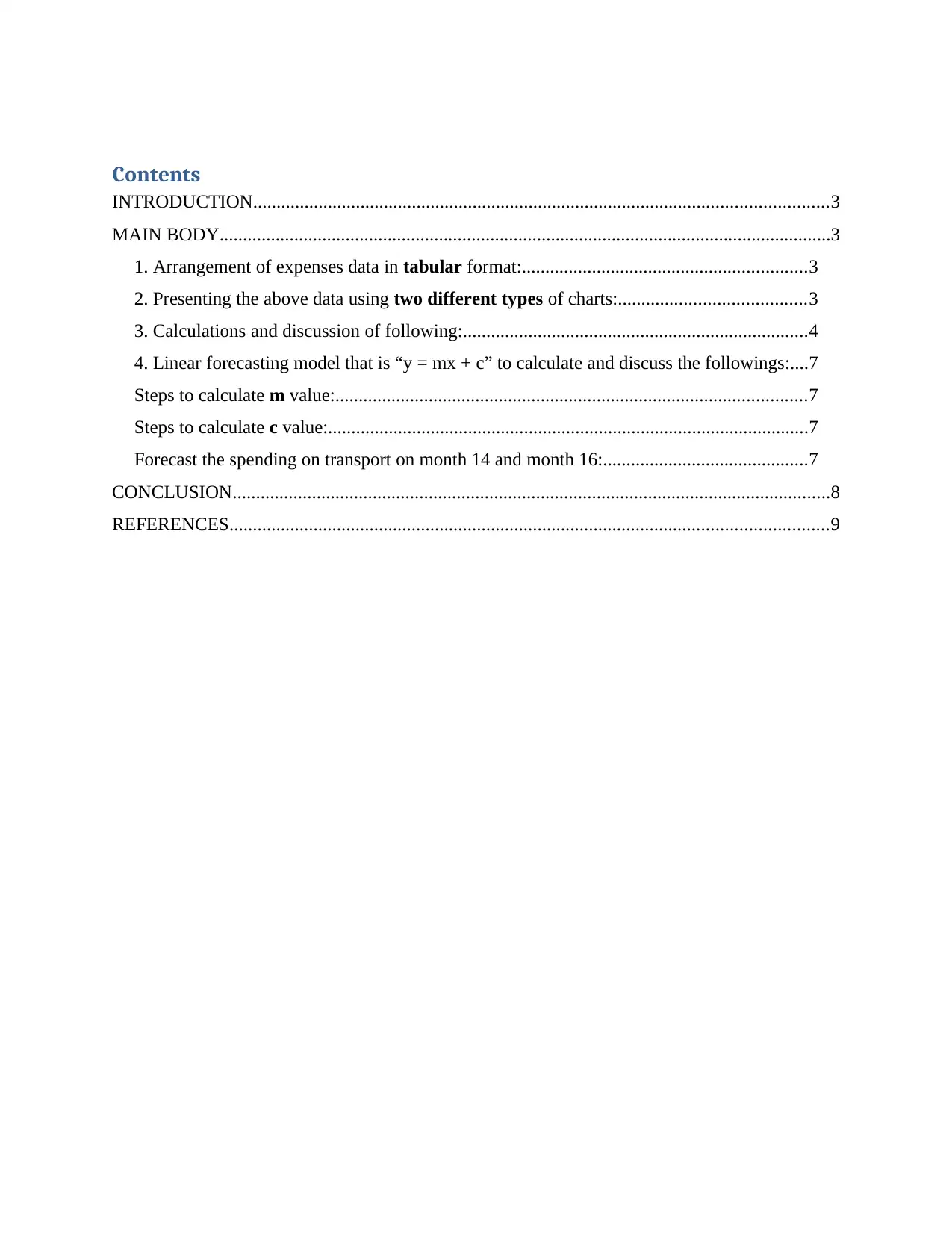
Contents
INTRODUCTION...........................................................................................................................3
MAIN BODY...................................................................................................................................3
1. Arrangement of expenses data in tabular format:.............................................................3
2. Presenting the above data using two different types of charts:........................................3
3. Calculations and discussion of following:..........................................................................4
4. Linear forecasting model that is “y = mx + c” to calculate and discuss the followings:....7
Steps to calculate m value:.....................................................................................................7
Steps to calculate c value:.......................................................................................................7
Forecast the spending on transport on month 14 and month 16:............................................7
CONCLUSION................................................................................................................................8
REFERENCES................................................................................................................................9
INTRODUCTION...........................................................................................................................3
MAIN BODY...................................................................................................................................3
1. Arrangement of expenses data in tabular format:.............................................................3
2. Presenting the above data using two different types of charts:........................................3
3. Calculations and discussion of following:..........................................................................4
4. Linear forecasting model that is “y = mx + c” to calculate and discuss the followings:....7
Steps to calculate m value:.....................................................................................................7
Steps to calculate c value:.......................................................................................................7
Forecast the spending on transport on month 14 and month 16:............................................7
CONCLUSION................................................................................................................................8
REFERENCES................................................................................................................................9
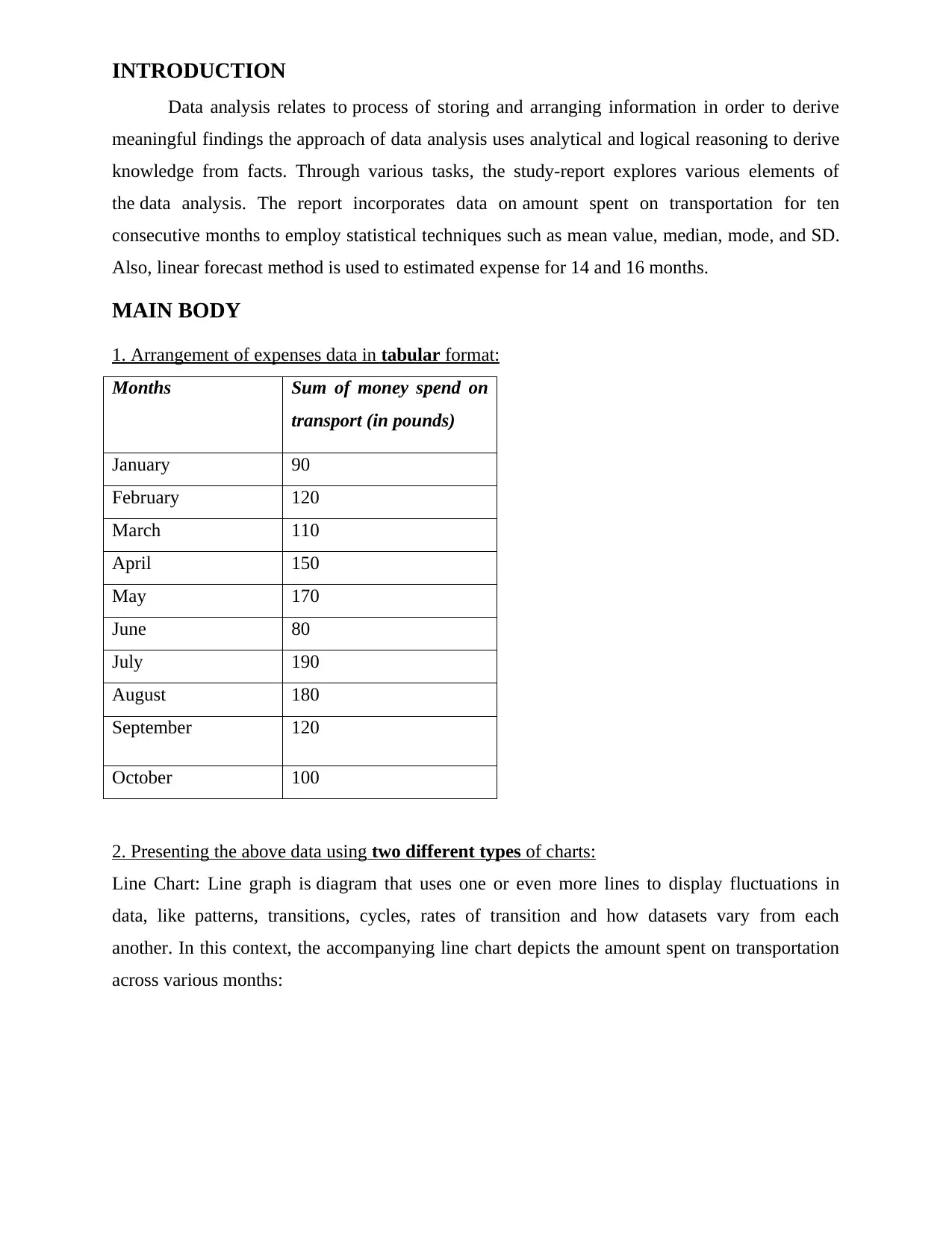
INTRODUCTION
Data analysis relates to process of storing and arranging information in order to derive
meaningful findings the approach of data analysis uses analytical and logical reasoning to derive
knowledge from facts. Through various tasks, the study-report explores various elements of
the data analysis. The report incorporates data on amount spent on transportation for ten
consecutive months to employ statistical techniques such as mean value, median, mode, and SD.
Also, linear forecast method is used to estimated expense for 14 and 16 months.
MAIN BODY
1. Arrangement of expenses data in tabular format:
Months Sum of money spend on
transport (in pounds)
January 90
February 120
March 110
April 150
May 170
June 80
July 190
August 180
September 120
October 100
2. Presenting the above data using two different types of charts:
Line Chart: Line graph is diagram that uses one or even more lines to display fluctuations in
data, like patterns, transitions, cycles, rates of transition and how datasets vary from each
another. In this context, the accompanying line chart depicts the amount spent on transportation
across various months:
Data analysis relates to process of storing and arranging information in order to derive
meaningful findings the approach of data analysis uses analytical and logical reasoning to derive
knowledge from facts. Through various tasks, the study-report explores various elements of
the data analysis. The report incorporates data on amount spent on transportation for ten
consecutive months to employ statistical techniques such as mean value, median, mode, and SD.
Also, linear forecast method is used to estimated expense for 14 and 16 months.
MAIN BODY
1. Arrangement of expenses data in tabular format:
Months Sum of money spend on
transport (in pounds)
January 90
February 120
March 110
April 150
May 170
June 80
July 190
August 180
September 120
October 100
2. Presenting the above data using two different types of charts:
Line Chart: Line graph is diagram that uses one or even more lines to display fluctuations in
data, like patterns, transitions, cycles, rates of transition and how datasets vary from each
another. In this context, the accompanying line chart depicts the amount spent on transportation
across various months:
⊘ This is a preview!⊘
Do you want full access?
Subscribe today to unlock all pages.

Trusted by 1+ million students worldwide

Column graph: This is simple Excel graph that depicts data series using verticallly column.
Column diagrams are effective way to show improvement over time because it's easy to compare
column sizes. Column diagrams, like bar graphs, could represent data in the part-to-whole
relationship instead of pie chart and these could be designed to display marginal and ordinal
figures.
3. Calculations and discussion of following:
I. Mean: A mean value is data point which represents the total of data points in set. given.
This is arithmetic mean value of given data set, measured by adding given all data points
togethers then dividing by no. of data-points in dataset. A most prevalent method for
Column diagrams are effective way to show improvement over time because it's easy to compare
column sizes. Column diagrams, like bar graphs, could represent data in the part-to-whole
relationship instead of pie chart and these could be designed to display marginal and ordinal
figures.
3. Calculations and discussion of following:
I. Mean: A mean value is data point which represents the total of data points in set. given.
This is arithmetic mean value of given data set, measured by adding given all data points
togethers then dividing by no. of data-points in dataset. A most prevalent method for
Paraphrase This Document
Need a fresh take? Get an instant paraphrase of this document with our AI Paraphraser
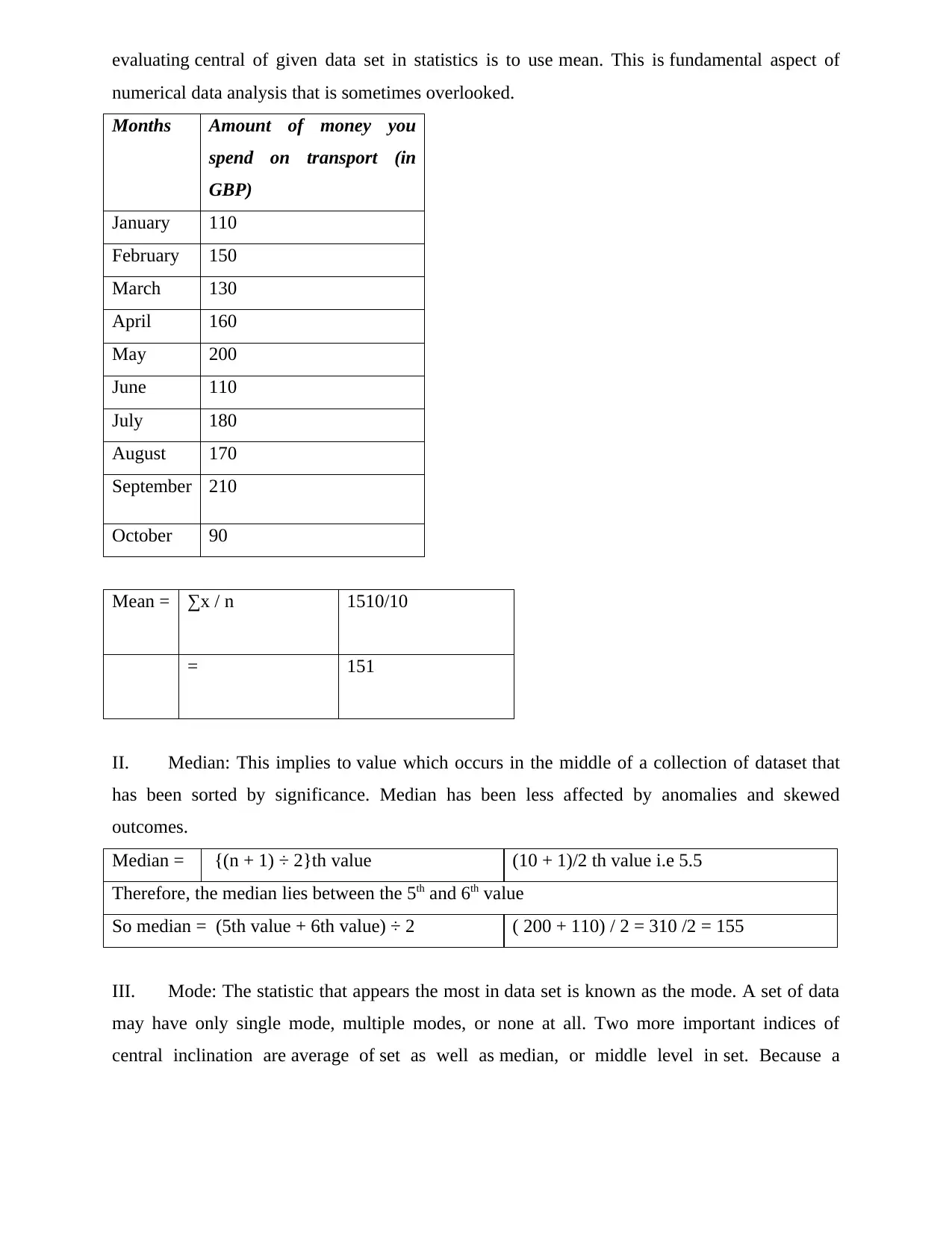
evaluating central of given data set in statistics is to use mean. This is fundamental aspect of
numerical data analysis that is sometimes overlooked.
Months Amount of money you
spend on transport (in
GBP)
January 110
February 150
March 130
April 160
May 200
June 110
July 180
August 170
September 210
October 90
Mean = ∑x / n 1510/10
= 151
II. Median: This implies to value which occurs in the middle of a collection of dataset that
has been sorted by significance. Median has been less affected by anomalies and skewed
outcomes.
Median = {(n + 1) ÷ 2}th value (10 + 1)/2 th value i.e 5.5
Therefore, the median lies between the 5th and 6th value
So median = (5th value + 6th value) ÷ 2 ( 200 + 110) / 2 = 310 /2 = 155
III. Mode: The statistic that appears the most in data set is known as the mode. A set of data
may have only single mode, multiple modes, or none at all. Two more important indices of
central inclination are average of set as well as median, or middle level in set. Because a
numerical data analysis that is sometimes overlooked.
Months Amount of money you
spend on transport (in
GBP)
January 110
February 150
March 130
April 160
May 200
June 110
July 180
August 170
September 210
October 90
Mean = ∑x / n 1510/10
= 151
II. Median: This implies to value which occurs in the middle of a collection of dataset that
has been sorted by significance. Median has been less affected by anomalies and skewed
outcomes.
Median = {(n + 1) ÷ 2}th value (10 + 1)/2 th value i.e 5.5
Therefore, the median lies between the 5th and 6th value
So median = (5th value + 6th value) ÷ 2 ( 200 + 110) / 2 = 310 /2 = 155
III. Mode: The statistic that appears the most in data set is known as the mode. A set of data
may have only single mode, multiple modes, or none at all. Two more important indices of
central inclination are average of set as well as median, or middle level in set. Because a
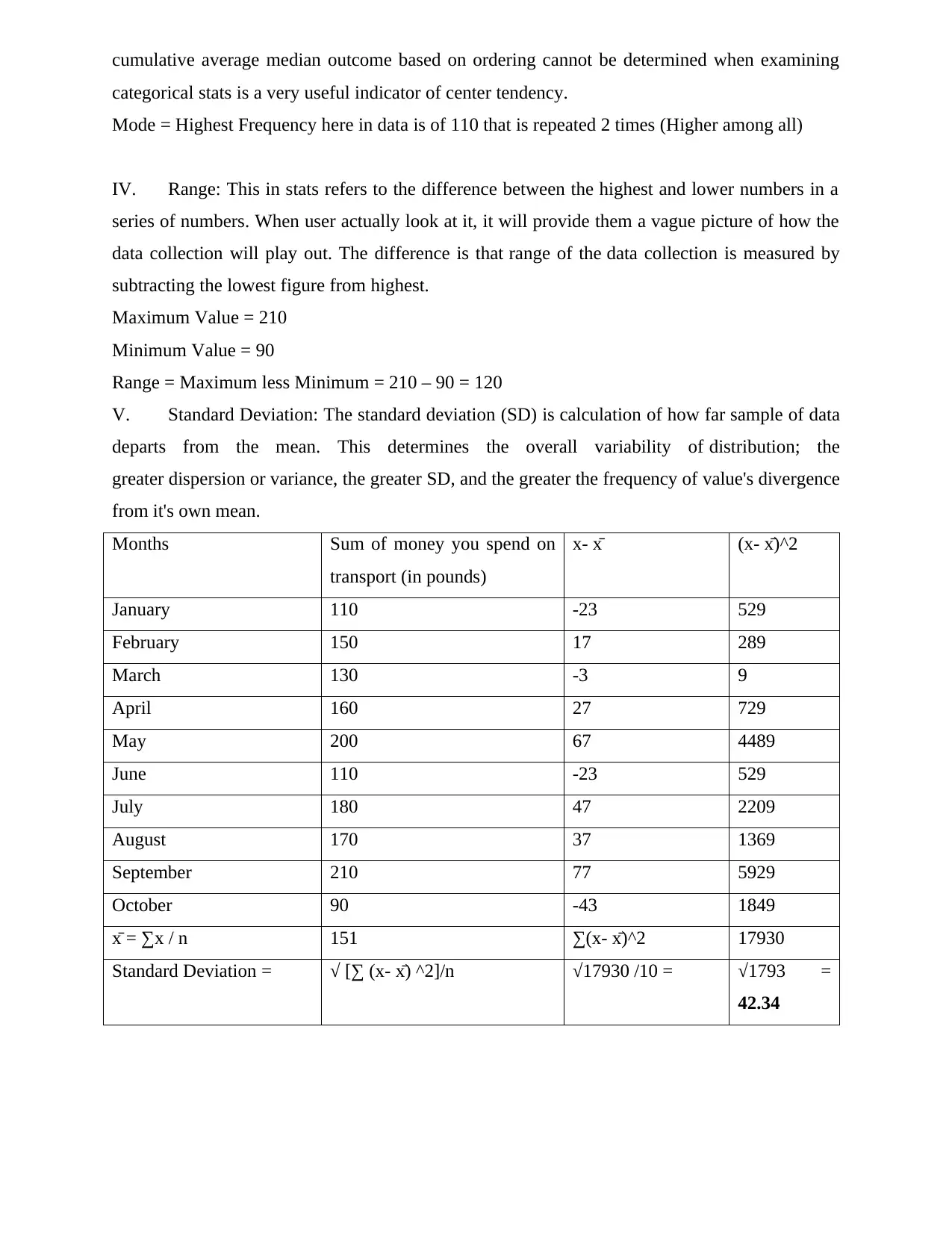
cumulative average median outcome based on ordering cannot be determined when examining
categorical stats is a very useful indicator of center tendency.
Mode = Highest Frequency here in data is of 110 that is repeated 2 times (Higher among all)
IV. Range: This in stats refers to the difference between the highest and lower numbers in a
series of numbers. When user actually look at it, it will provide them a vague picture of how the
data collection will play out. The difference is that range of the data collection is measured by
subtracting the lowest figure from highest.
Maximum Value = 210
Minimum Value = 90
Range = Maximum less Minimum = 210 – 90 = 120
V. Standard Deviation: The standard deviation (SD) is calculation of how far sample of data
departs from the mean. This determines the overall variability of distribution; the
greater dispersion or variance, the greater SD, and the greater the frequency of value's divergence
from it's own mean.
Months Sum of money you spend on
transport (in pounds)
x- x̄ (x- x̄)^2
January 110 -23 529
February 150 17 289
March 130 -3 9
April 160 27 729
May 200 67 4489
June 110 -23 529
July 180 47 2209
August 170 37 1369
September 210 77 5929
October 90 -43 1849
x̄ = ∑x / n 151 ∑(x- x̄)^2 17930
Standard Deviation = √ [∑ (x- x̄) ^2]/n √17930 /10 = √1793 =
42.34
categorical stats is a very useful indicator of center tendency.
Mode = Highest Frequency here in data is of 110 that is repeated 2 times (Higher among all)
IV. Range: This in stats refers to the difference between the highest and lower numbers in a
series of numbers. When user actually look at it, it will provide them a vague picture of how the
data collection will play out. The difference is that range of the data collection is measured by
subtracting the lowest figure from highest.
Maximum Value = 210
Minimum Value = 90
Range = Maximum less Minimum = 210 – 90 = 120
V. Standard Deviation: The standard deviation (SD) is calculation of how far sample of data
departs from the mean. This determines the overall variability of distribution; the
greater dispersion or variance, the greater SD, and the greater the frequency of value's divergence
from it's own mean.
Months Sum of money you spend on
transport (in pounds)
x- x̄ (x- x̄)^2
January 110 -23 529
February 150 17 289
March 130 -3 9
April 160 27 729
May 200 67 4489
June 110 -23 529
July 180 47 2209
August 170 37 1369
September 210 77 5929
October 90 -43 1849
x̄ = ∑x / n 151 ∑(x- x̄)^2 17930
Standard Deviation = √ [∑ (x- x̄) ^2]/n √17930 /10 = √1793 =
42.34
⊘ This is a preview!⊘
Do you want full access?
Subscribe today to unlock all pages.

Trusted by 1+ million students worldwide
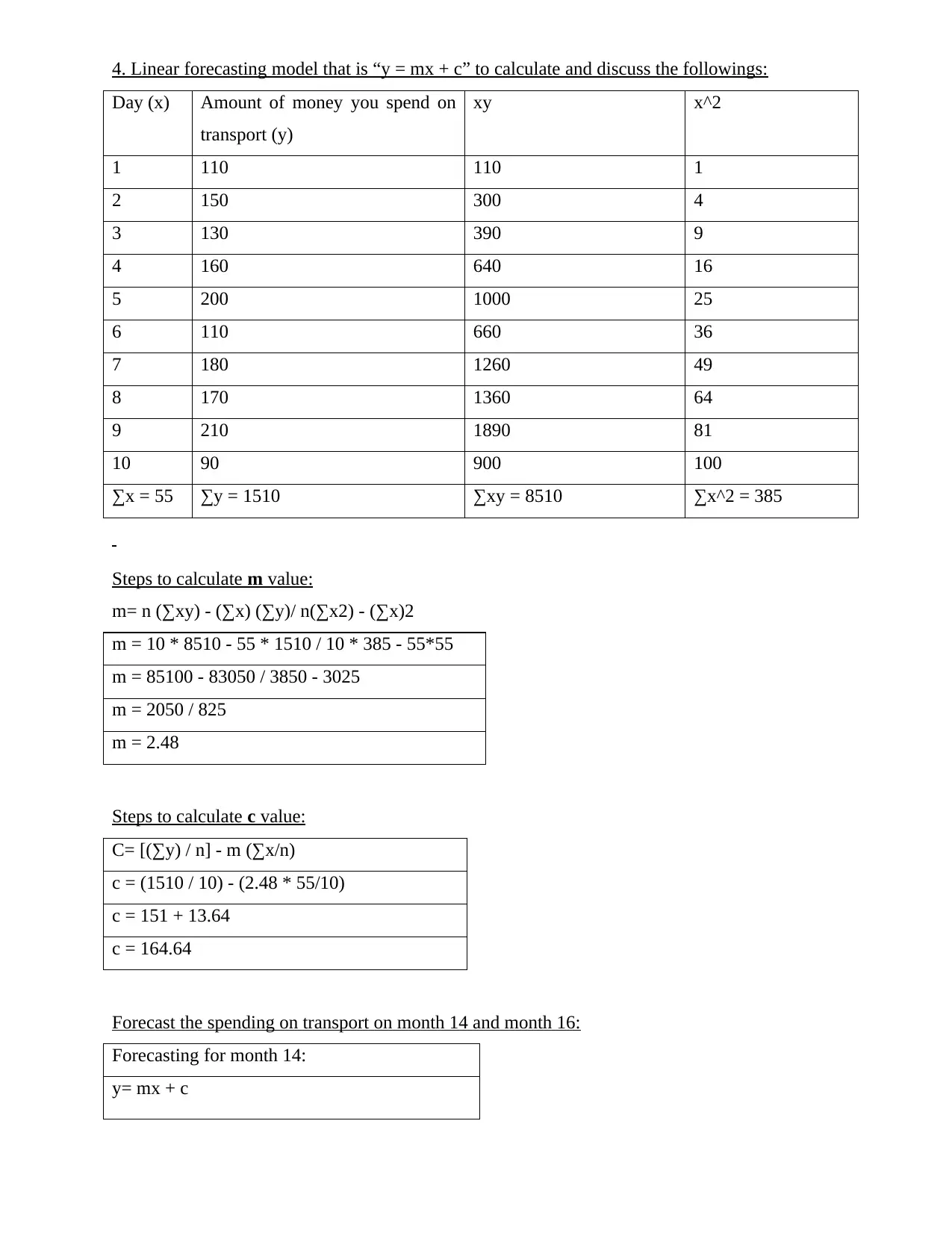
4. Linear forecasting model that is “y = mx + c” to calculate and discuss the followings:
Day (x) Amount of money you spend on
transport (y)
xy x^2
1 110 110 1
2 150 300 4
3 130 390 9
4 160 640 16
5 200 1000 25
6 110 660 36
7 180 1260 49
8 170 1360 64
9 210 1890 81
10 90 900 100
∑x = 55 ∑y = 1510 ∑xy = 8510 ∑x^2 = 385
Steps to calculate m value:
m= n (∑xy) - (∑x) (∑y)/ n(∑x2) - (∑x)2
m = 10 * 8510 - 55 * 1510 / 10 * 385 - 55*55
m = 85100 - 83050 / 3850 - 3025
m = 2050 / 825
m = 2.48
Steps to calculate c value:
C= [(∑y) / n] - m (∑x/n)
c = (1510 / 10) - (2.48 * 55/10)
c = 151 + 13.64
c = 164.64
Forecast the spending on transport on month 14 and month 16:
Forecasting for month 14:
y= mx + c
Day (x) Amount of money you spend on
transport (y)
xy x^2
1 110 110 1
2 150 300 4
3 130 390 9
4 160 640 16
5 200 1000 25
6 110 660 36
7 180 1260 49
8 170 1360 64
9 210 1890 81
10 90 900 100
∑x = 55 ∑y = 1510 ∑xy = 8510 ∑x^2 = 385
Steps to calculate m value:
m= n (∑xy) - (∑x) (∑y)/ n(∑x2) - (∑x)2
m = 10 * 8510 - 55 * 1510 / 10 * 385 - 55*55
m = 85100 - 83050 / 3850 - 3025
m = 2050 / 825
m = 2.48
Steps to calculate c value:
C= [(∑y) / n] - m (∑x/n)
c = (1510 / 10) - (2.48 * 55/10)
c = 151 + 13.64
c = 164.64
Forecast the spending on transport on month 14 and month 16:
Forecasting for month 14:
y= mx + c
Paraphrase This Document
Need a fresh take? Get an instant paraphrase of this document with our AI Paraphraser

y = 2.48 * 14 + 164.64
198.94
Forecasting for month 16:
y= mx + c
y = 2.48 * 16 + 164.64
= 204.32
CONCLUSION
According to the findings of the report, data analysis is needed for making well-informed
and successful decisions. The main aim of the data analysis being to recognize meaning of data
so that information gathered can be used to make smart decisions. The practice of analyzing data
using mathematical techniques in attempt to discover useful information is referred to as the data
analysis.
198.94
Forecasting for month 16:
y= mx + c
y = 2.48 * 16 + 164.64
= 204.32
CONCLUSION
According to the findings of the report, data analysis is needed for making well-informed
and successful decisions. The main aim of the data analysis being to recognize meaning of data
so that information gathered can be used to make smart decisions. The practice of analyzing data
using mathematical techniques in attempt to discover useful information is referred to as the data
analysis.

REFERENCES
Books and Journals:
Bruno, T.J. and Svoronos, P.D., 2020. CRC Handbook of Basic Tables for Chemical Analysis:
Data-driven Methods and Interpretation. CRC press.
Chen, G., Ning, B. and Shi, T., 2019. Single-cell RNA-Seq technologies and related
computational data analysis. Frontiers in genetics, 10, p.317.
Kowarski, K.A. and Moors‐Murphy, H., 2020. A review of big data analysis methods for baleen
whale passive acoustic monitoring. Marine Mammal Science.
Vialetto, G. and Noro, M., 2020. An innovative approach to design cogeneration systems based
on big data analysis and use of clustering methods. Energy Conversion and
Management, 214, p.112901.
Books and Journals:
Bruno, T.J. and Svoronos, P.D., 2020. CRC Handbook of Basic Tables for Chemical Analysis:
Data-driven Methods and Interpretation. CRC press.
Chen, G., Ning, B. and Shi, T., 2019. Single-cell RNA-Seq technologies and related
computational data analysis. Frontiers in genetics, 10, p.317.
Kowarski, K.A. and Moors‐Murphy, H., 2020. A review of big data analysis methods for baleen
whale passive acoustic monitoring. Marine Mammal Science.
Vialetto, G. and Noro, M., 2020. An innovative approach to design cogeneration systems based
on big data analysis and use of clustering methods. Energy Conversion and
Management, 214, p.112901.
⊘ This is a preview!⊘
Do you want full access?
Subscribe today to unlock all pages.

Trusted by 1+ million students worldwide
1 out of 9
Related Documents
Your All-in-One AI-Powered Toolkit for Academic Success.
+13062052269
info@desklib.com
Available 24*7 on WhatsApp / Email
![[object Object]](/_next/static/media/star-bottom.7253800d.svg)
Unlock your academic potential
Copyright © 2020–2025 A2Z Services. All Rights Reserved. Developed and managed by ZUCOL.





